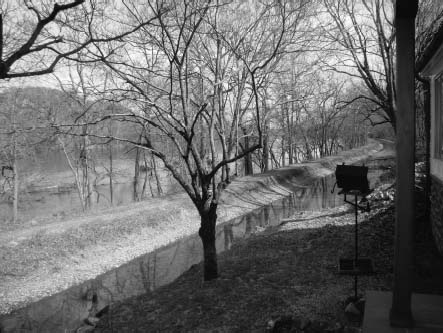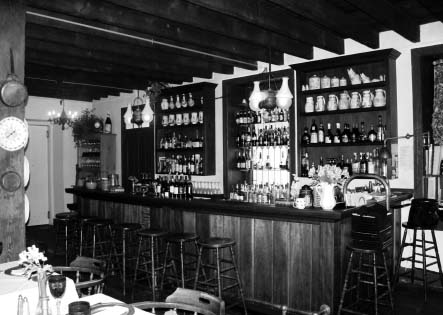The Delaware Canal (10 page)
Read The Delaware Canal Online
Authors: Marie Murphy Duess


Homes located on the canal often accommodated the boatmen with food, drink and stabling for their mules. This home was originally built in 1740 and was licensed as Beaumont's Tavern. Because of its proximity to the canal and the remnants of a bridge nearby, it is likely that it stabled mules for the night and offered provisions to the canallers.
Courtesy of Jim and Tina Greenwood
.
Once the canallers arrived in New Hope, they had their choice of spots to imbibe. Originally called Coryell's Ferry, the village was a major encampment during the Revolution, and in the years following the war, development in the village grew when merchant Benjamin Parry made it his home and built his Hope Mills there. When the mills burned down, he rebuilt and renamed them New Hope Mills, and eventually the town adopted the name. The building of the Delaware Division Canal helped to establish New Hope as a central district. Four locks were located in the borough, including an outlet lock to the New Jersey side of the river connecting to the Raritan and Delaware Canal.
The River House, which was built in 1794, was a favorite stop for the boatmen. After the canal years, it became known as Chez Odette's (owned by a French actress who starred in movies and onstage and who made her home in New Hope), but three major floods in the early 2000s finally closed this famous restaurant.
A rather popular brothel called the Bucket of Blood was always accommodating to the canallers who were so inclined to accept hospitality there. Although the renowned Logan Inn is located on the canal, it was a hotel for more sophisticated tastes and pocketbooks, and boatmen rarely, if ever, slept off their boats. Established in 1722 by John Wells, the founder of New Hope, the Logan Inn is one of the oldest continuously run taverns in Bucks County and is listed in the National Register of Historic Places. During the Revolutionary War, George Washington stayed at the Logan numerous times, and during the summer of 1777, General Benedict Arnold headquartered thereâbefore he became a notorious traitor. Since New Hope was the halfway mark between Easton and Bristol, the boatmen restocked many of their supplies there. The Defiance Cigar Store and T.E. Watson's provided cigars and chewing tobacco, and in the borough close to the canal there were livery stables, a harness maker, a foundry, a flax factory, a fishery, a shoemaker, a milliner, a lumber merchant and four doctors. A good deal of mule trading took place in New Hope as well.
Once they were north of New Hope, the boatmen passed through several small communities that, before the appearance of the canal, had been sleepy little villages. One of them was Centre Bridge, a charming village connected from Pennsylvania to New Jersey in 1814 by a suspension bridge. There is no lock for the canal at Centre Bridge and so it was not a regular meeting place of canal men, as they rarely stopped between locks. But the area was a favorite of some of the American impressionists who set up studios and purchased homes in the picturesque surroundings. The Centre Bridge Inn is entwined with the history of the canal simply because of its proximity, and when the present owners, Tina and Jerry Horan, purchased the Centre Bridge Inn, they were given a lease to run the New Hope Canal Boat Company, which provides interpretive boat rides for passengers between Centre Bridge and New Hope. Drawn by mule teamsâDot, Dolly, Joe and Daffodilâthese rides include a boat captain who explains what life along the canal was like in the nineteenth and early twentieth centuries. When not being used for interpretive presentations, the boats convey small private parties from the restaurant to give passengers a feel for what it was like when the canal was used for recreational purposes on Sundays. Not unlike many of the establishments along the Delaware River that have been hit hard by recent floods, the Horans have worked nonstop in partnership with the Delaware Canal State Park to keep the canal repaired and maintained.
Located about one and a half miles north of Centre Bridge was a place called the Cake and Beer House, where boatmen stopped for the night, stabled their mules and ate.

The Centre Bridge Inn continues to offer respite to weary travelersâinside and on canal barges built and operated to keep the history of the canal alive.
Courtesy of Center Bridge Inn and New Hope Canal Boat Company
.
The Black Bass Hotel (once called the Lumberville House) was also famous for feeding and accommodating canal men, along with lumbermen who worked in the mills there. Lumberville was founded by Colonel George Wall, an officer in the Continental army, and even before the Delaware Canal was built, Lumberville was a thriving locale due to the abundance of fine treesâwhite pine, spruce, hemlock, oak, beech and chestnutâused for shipbuilding and houses. In the early days, the logs were cut, hauled to the river and floated down to Philadelphia from Lumberville. When mills were established to cut the wood for easier transportation and sale, the lumber was loaded on boats and brought to its destination by the canal. Because of the town's proximity to the river, some of the original businesses located along the main river road had to be eliminated to make room for the canal, and the doors of houses that fronted the river were relocated to the back of their homes in order to gain access to the redirected road.
43
The LC&N stored blasting powder and other supplies at the Black Bass, which almost resulted in a tragedy when the hotel caught fire one night. If it had not been for the courage of the owner, Major Anthony Fry, who ran into the burning building to remove the explosives, it would have been blown to pieces along with some of the town. Today, despite the many floods it has endured, this establishment is a renowned bed-and-breakfast, hosting guests from all over the world.
Jacob Oberacker ran an establishment called the Delaware House in Erwinna, and it became one of the canallers' favorite stops. Oberacker provided a change of mules, beer, salt cakes (similar to soft pretzels) and a bed for the night. Today it is called the Golden Pheasant Inn and is on the National Registry of Historic Places. Its owners, Barbara and Michel Faure, continue to serve travelers in this charming bed-and-breakfast. Sitting on the outdoor terrace overlooking the canal, it is easy to envision what it was like during the height of the canal era.
Benjamin Riegel founded a town and built a tavern along the Delaware Canal in 1838. Soon after, Canal Street in Riegelsville became one of the largest industrial manufacturing centers in America, dotted with mills and factories, including a paper mill owned by the Riegel family. Mansions were built on its hillsides, and the town remained prosperous well into the twentieth century. It is still one of the most charming towns along the canal.
Many communities sprung up along the canal simply to supply provisions for the important waterway, and with the demise of the canal, many of them faded away again. Shipbuilders closed their doors, taverns closed down and stables weren't needed any longer. Except for two or three, the stores in which boatmen and locals gathered around the stove to exchange gossip, argue politics and complain about the LC&N are gone. Sadly, most of the covered bridges along the canal were washed away by floods.

Boatmen stopping at Jacob Oberacker's would be served salt cakes similar to our soft pretzels. Today, this favorite stop of the canallers is called the Golden Pheasant and is owned by Michel and Barbara Faure.
Courtesy of the Golden Pheasant Inn, Erwinna, PA
.

The barroom at the Golden Pheasant, then called the Delaware House, served boatmen during the height of the canal age.
Courtesy of the Golden Pheasant Inn, Erwinna, PA
.
However, several suspension bridges that cross over the canal and the river remain, as do many of the charming camelback bridges. Bridges in Washington's Crossing, New Hope, Centre Bridge and Riegelsville are all open to pedestrians and offer beautiful views of the river and canal.
Keeping soap on the boat was a problem for the canallers because when the soap was wet, it often slipped from a person's hands, plopped into the canal from the deck of the boat and sank into the silt and mud at the bottom of the canal, never to be seen again. Losing brown soap to the bottom of the canal was a common complaint of the boatmen.
The owner of the store on the Morris Canal in 1891 decided to stock a new brand of soap that was white. He believed that the new Proctor & Gamble product, Ivory soap, might be easier for the boatmen to see at the bottom of the canal and they would be able to fish it out with a scoop.
A canal captain bought a bar of the white soap from the merchant and decided to use it right away. As anticipated, the fresh bar of soap slipped out of his hands and into the canal. Annoyed that he was about to lose a brand-new bar of soap, he grabbed the scoop immediately and rushed to the side of the boat to see if he could find it before it sank all the way to the bottom. Much to his surprise, he found the cake of soap floating beside the boat. He scooped it up, amazed and delighted with his new floating soap.
He was so impressed, in fact, that he was quick to share his discovery of the new soap with every boatman he passed. He spread the news of the floating soap up and down the canal and in Phillipsburg and Mauch Chunk when he was filling up his boat with coal. Soon, all the canal men who had access to the store that carried Ivory soap bought several cakes to keep on their boats.
A representative of Proctor & Gamble was curious when he saw the huge amounts of soap the store proprietor was selling, and he visited the store to inquire as to why the soap was selling so well there. The proprietor informed the representative that the canal men discovered “Ivory soap, it floats.” And so began the slogan for Ivory soap.
44
Or at least that's one story. Another, less amusing, is that Harley Proctor, after a chemist listed the ingredients in percentages, wrote the slogan “99â44/100
ths
Percent Pure: It Floats.” The canal store owner's story is more fun.

Ivory soap was the choice of the canallers when they discovered it floated instead of sinking to the bottom of the canal.
Author's collection
.
